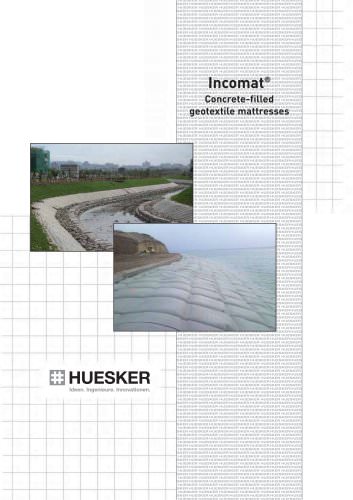
Catalog excerpts

Base Reinforcement Geosynthetics for Roads and Pavements
Open the catalog to page 1
Geogrids for base reinforcement The unbound layers of roads, paths and other pavements are subject to stringent requirements in terms of bearing capacity. Where the subgrade exhibits insufficient strength, additional measures often need to be taken to achieve the required bearing capacity. Here, geosynthetics-based systems are becoming an increasingly popular alternative to standard techniques such as soil replacement or cement/lime stabilization. HUESKER‘s geogrid products for base reinforcement are a case in point: their application saves valuable resources and frequently delivers a more...
Open the catalog to page 2
Design goals met by HUESKER‘s base reinforcement geogrids: • Increase in bearing capacity or reduction in required base course thickness, particularly for weak subgrades. Indeed, in exceptionally poor ground conditions, the installation of a base course only becomes possible through the use of HUESKER geogrids. • Decrease in rutting on unbound pavement structures permanently exposed to track-making vehicles (e.g. heavy construction site traffic). Not only does reduced rut formation cut the cost of reprofiling, it also ensures the steady flow of site traffic. • Bridging and evening out of...
Open the catalog to page 3
Thanks to their flexibility, HUESKER geogrids adapt perfectly to the shape of the granular base material. The resulting prestress in the grid allows the direct accommodation of loads through friction at the contact surface between the geogrid and the fractured faces of the stone material. The interlock between the granular base material and the apertures of the grid is such as to ensure the immediate mobilization of sufficient tensile strength at the required location. The resulting “rigid” base course increases the bearing capacity of the overall system while efficiently offsetting any...
Open the catalog to page 4
A distinction can be drawn between the various mechanisms that operate when HUESKER‘s geogrids are used for base reinforcement. A. Membrane effect The membrane effect ensures the accommodation of loads, among other things, through optimum interlock between the reinforcement grid and surrounding soil or base material and through friction at the contact surface between the geogrid and the fractured faces of the stone material. As a rule, the forces acting on the ground take the form of vertical wheel loads. In weak subgrades, this action results in vertical deformation. Ideally, the geogrid...
Open the catalog to page 5
Construction installation damage Most instances of damage to geogrids occur during installation and compaction of the granular base material. During manufacture, HUESKER geogrids are finished with a polymer coating to protect them against both installation damage and UV radiation. The inherent flexibility of our geogrids enables them to wrap easily around the granular material, thus avoiding or reducing stress concentrations on the ribs of the grid. This helps to minimize damage to the grids, especially during compaction. Additional benefits result from the use of multifilament yarn in the...
Open the catalog to page 6
Applications HUESKER geogrids essentially lend themselves to use wherever base courses need to be installed on weak subgrades. A distinction can be drawn between temporary and permanent applications. HUESKER‘s Fornit®, Fortrac®, Comtrac® and Base geogrids offer useful additional alternatives in response to special, project-specific requirements. The main applications are as follows: Installation of reinforced base courses for highways Installation of base courses in airport engineering and runway shoulders Construction of roads with unbound surface courses Installation of reinforced base...
Open the catalog to page 7
08/13 B Copyright by HUESKER Synthetic GmbH, Gescher Link to image film:
Open the catalog to page 8All Huesker catalogs and technical brochures
-
Agritec®
4 Pages
-
Basetrac®
11 Pages
-
Handling Waterbodies Responsibly
13 Pages
-
Incomat®
9 Pages
-
eco LINE
3 Pages
-
Fortrac® 3D Geogrid
5 Pages
-
Basetrac
11 Pages
-
Tektoseal Sand
2 Pages
-
Tektoseal Clay
3 Pages
-
SoilTain Dewatering
7 Pages
-
NaBento
6 Pages
-
HaTe
4 Pages
-
Tektoseal® Sand
2 Pages
-
Ringtrac®
9 Pages
-
HaTelit® BL
4 Pages
-
SamiGrid
4 Pages
-
SoilTain® Dewatering Tubes
4 Pages
-
Incomat
16 Pages
-
CANAL3
8 Pages
-
Stabilenka
6 Pages
-
Robutec
4 Pages
-
HaTe® Nonwowen
4 Pages
-
Geosynthetics
12 Pages
-
COVERTEC - Biogas and Manure
8 Pages
-
Tektoseal®
4 Pages
-
Ventitec
6 Pages
-
Lubratec
12 Pages
-
AGRAR
8 Pages
-
HaTelit ®
12 Pages
-
Fortrac ®
12 Pages
-
Fortrac 3D ®
6 Pages
-
Fornit ®
6 Pages
-
Comtrac ®
4 Pages









































